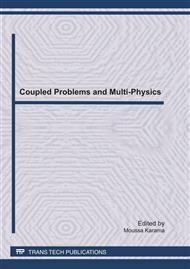p.13
p.23
p.33
p.43
p.53
p.61
p.71
p.81
p.91
Study of the Interaction of Shock Wave / Laminar Boundary Layer
Abstract:
We are interested In this study to the interaction between oblique shock wave, induced by a surface of a supersonic nozzle with an angle of inclination of θw=8.5°, by a laminar boundary layer generated by a flat surface (reflection of oblique shock on a flat wall) . We studied also the problem of the development of the interaction zone and its unsteadiness. Our study is based on complex numerical simulation of interaction of shock wave / boundary layer and on their disturbance found within the interaction zone. This is the area of unsteady physical characteristics. This study was conducted under condition that the flow is compressible, of laminar and two-dimensional character. We treated also the point of detachment of the boundary layer by varying the value of the upstream Mach number. We compared our results (obtained by the commercial code FLUENT) with those found numerically and experimentally.
Info:
Periodical:
Pages:
53-60
Citation:
Online since:
July 2011
Price:
Сopyright:
© 2011 Trans Tech Publications Ltd. All Rights Reserved
Share:
Citation:


